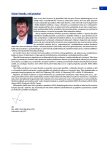Overinsulinization – the frequent cause of unsatisfactory glycemic control: case reports
Authors:
Mariana Rončáková; Michaela Mišaníková; Arash Davani; Ľudmila Bosíková; Silvia Dókušová; Emil Martinka
Authors‘ workplace:
Národný endokrinologický a diabetologický ústav, n. o., Ľubochňa
Published in:
Forum Diab 2017; 6(2): 91-94
Category:
Case Report
Overview
By means of case reports, we wish to draw attention to the “hyperinsulinemic” syndrome / hyperinsulinemia, i.e. treatment by excessive doses of insulin, which appears quite frequently in clinical practice, while being overlooked with equal frequency. Excessive insulin doses induce secondary insulin resistance and increased blood glucose levels, which may encourage further increase of insulin doses. The possibility of excessive insulin treatment should be primarily considered in situations where a daily insulin dose exceeds 1.0–1.2 IU/kg body weight (BW), the patient gains more weight than normally expected, he/she has frequent fluctuations in blood glucose levels (alternating hypo- and hyperglycemia), or blood glucose levels are permanently increased (typically within 13–17 mmol/l) and do not respond to further increase of insulin doses, or may get even worse, or hidden hypoglycemia appears with counterregulatory hyperglycemia. The solution consists in the gradual reduction of insulin doses (approximately 10–15 % of the total daily dose) once in 2–3 days until reaching a dose of 0.5–0.6 IU/kg BW, or according to the response of blood glucose levels. Should blood glucose levels be not adjusted, the patient cooperation should be reconsidered, or another cause should be sought, such as severe insulin resistance, chronic inflammation, endocrine causes or individual ineffectiveness of a specific insulin analogue in a particular patient to be replaced by another type of insulin.
Key words:
insulinotherapy, excessive insulin treatment, unsatisfactory glycemic control, overinsulinization
Received:
25. 4. 2017
Accepted:
9. 5. 2017
Sources
1. American Diabetes Association. Standards of medical care in diabetes – 2017. Diabetes Care 2017; 36(Suppl 1): S1–S135.
2. Martinka E, Uličiansky V, Mokáň M et al. Konsenzuálny terapeutický algoritmus pre diabetes mellitus 2. typu. Forum Diab 2016; 5(2): 99–108. Dostupné z WWW: <http://www.forumdiabetologicum.sk/forum-diabetologicum-clanek/konsenzualny-terapeuticky-algoritmus-pre-diabetes-mellitus-2-typu-v-sulade-s-spc-aktualnym-znenim-indikacnych-58423?confirm_rules=1>.
3. Dailey AM, Tannock LR. Extreme insulin resistance: indications and approaches to the use of U-500 insulin in type 2 diabetes mellitus. Curr Diab Rep 2011; 11(2): 77–82. Dostupné z DOI: <http://dx.doi.org/10.1007/s11892–010–0167–6>.
4. Cochran E, Musso C, Gorden P. The use of U-500 in patients with extreme insulin resistance. Diabetes Care 2005; 28(5): 1240–1244. Erratum in Diabetes Care 2007; 30(4):1035.
5. Mokáň M, Martinka E, Galajda P et al. Diabetes mellitus a vybrané metabolické ochorenia. P + M: Martin 2008. S21-S-95. ISBN 978–80–969713–9-8.
Labels
Diabetology Endocrinology Internal medicineArticle was published in
Forum Diabetologicum

2017 Issue 2
Most read in this issue
- Overinsulinization – the frequent cause of unsatisfactory glycemic control: case reports
- Insulin in the therapeutic scheme for type 2 diabetes mellitus
- Insulin therapy during pregnancy
- Factors conducive to optimal control of type 1 diabetes mellitus in childhood and adolescence
